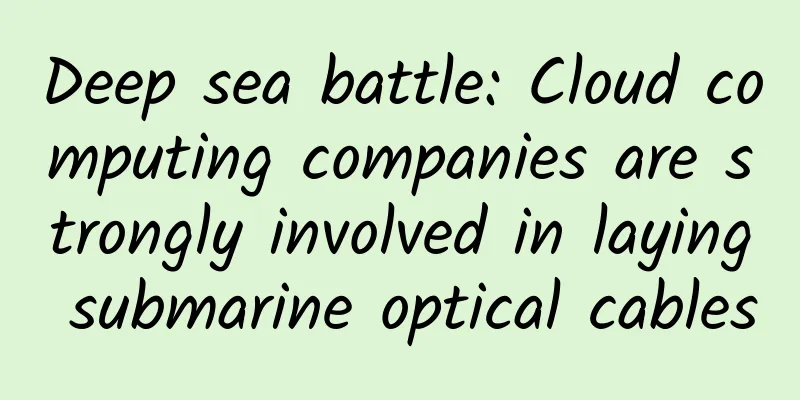Deep sea battle: Cloud computing companies are strongly involved in laying submarine optical cables

|
I was thinking of writing about this topic by accident. Last weekend, while browsing the articles in The Economist, I saw an industry-related dynamic and decided to take a look at the layout of several major cloud computing giants in the deep-sea optical cable market. Laying optical cables and controlling transmission networks Before discussing the current status of submarine cables of mainstream cloud computing vendors, let’s first talk about why cloud computing companies want to lay submarine cables. According to data from market research company TeleGeography, in 2016, the communication traffic reached 3,544 terabits per second, about twice that of 2014. Obviously, the data in 2017 will be even more exaggerated. How to make communication traffic quickly transmitted between these large-scale data center networks has always been a problem that cloud computing vendors have been working on. We all know that cloud computing companies are building large data centers all over the world. These data centers are increasingly becoming important nodes for global traffic and forming a global network. According to past experience, these cloud computing companies only need to rent submarine optical cables operated by telecom operators for data transmission, and do not need to build their own networks. However, with the explosive growth of network data transmission volume, cloud computing companies are increasingly tempted to build their own backbone networks. Looking to the future, data exchange between cloud computing companies' data centers will be more frequent than ever before, and the amount of data will be more terrifying. There are many benefits to building your own submarine fiber optic network. On the one hand, you have more broadband resources, the cost of building it yourself is lower, and the fiber optic cable you design transmits data faster, greatly reducing network latency. Most importantly, I have the final say on how to use this broadband. For these reasons, it is not difficult to understand why many cloud computing companies have begun to make large-scale investments in this area. According to TeleGeography forecasts, a total of $9.3 billion was spent on such cable projects between 2016 and 2018, five times more than in the previous three years. Investment and use, cloud computing vendors intensively involved After explaining why cloud computing giants build their own submarine optical fibers, let's take a look at how these manufacturers are doing in the vast deep sea. The core data comes from professional market research organization TeleGeography. See the table below for details. We can make the following observations: 1. Cloud computing companies are the main users of submarine optical fibers. According to statistics, among the 12 submarine cables across the continents, Google, Microsoft, Facebook, and AWS are the main users, which shows that they have a huge demand for intercontinental mass data transmission. Among them, Google uses the most, followed by Microsoft, then Facebook, and finally Amazon AWS. 2. Cloud computing companies are beginning to get involved in fiber optic construction. According to statistics, in the past three years, Google, Microsoft, and Facebook have increasingly been involved in the construction of new submarine cables and have become shareholders of multiple fiber optic networks. It is worth noting that in the process of laying many optical fibers, these cloud computing companies still need to cooperate with operators. The New Cross Pacific (NCP) Cable System, a fiber-optic line connecting China, Japan, South Korea and the United States, will be put into operation in 2018. It is 13,618 kilometers long and China Telecom, China Unicom, Chunghwa Telecom, China Mobile, Microsoft and Softbank are the investors behind it. 3. From the perspective of submarine optical fiber connection locations, the United States ranks first, followed by China, Japan, South Korea and Southeast Asia in Asia, and then the United Kingdom and Ireland in Europe. Brazil and Uruguay in South America, Australia in Oceania and other places also have submarine optical fiber access. The entire submarine optical fiber network has been initially formed. Cloud computing vendors will become new service providers What does the construction of such a high-speed data transmission network mean for cloud computing companies? In the short term, this will give cloud computing vendors more power, making them more capable of carrying massive amounts of data and improving their control over data transmission networks, but in the long term, this may be a redefinition of the concept of operators. I once wrote an article titled "Amazon AWS has become a new type of operator." The general idea is that cloud computing vendors have set up multiple large-scale data centers around the world, and once these data centers are connected into a network through submarine optical fibers, a new type of data operator will emerge. These will be service providers that are more powerful and more capable of monopolizing than telecom operators, because in addition to controlling the data transmission pipelines, they also control more and more data, locking in more and more companies and the end customers of these companies. |
<<: On the first day after Double Eleven, I heard that programmers all went here to "carnival"...
>>: Sparks from blockchain and the Internet of Things
Recommend
Uncover the mysterious navigation behind the Internet, DNS domain name resolution
In the vast information system of the Internet, D...
Five API Gateway Technology Options
This article intends to discuss gateways around s...
How 5G and WiFi 6 will impact critical sensor applications
We live in an age where wireless communications a...
Three major problems facing my country's 5G base stations
At present, the development of 5G commercializati...
IDC: Ten predictions for China's ICT market in 2021
On November 10, IDC recently released the "T...
5G Era: Say Goodbye to TCP/IP
I just don't love you anymore, a song that ca...
In 2017, more than 200 operators around the world planned to incorporate 5G network architecture elements into their 4G networks.
[[182055]] Deloitte’s Technology, Media and Telec...
The human resources industry embraces electronic contracts and explores the path of exponential organizational innovation
[51CTO.com original article] On November 26, HRA ...
A brief analysis of RoCE network technology
In the era of data being king, people have more s...
Ready to use right out of the box? StreamNative Platform 1.0 is now available
Recently, StreamNative solemnly announced the rel...
Kunpeng University Tour is coming soon. How can the Sichuan-Chongqing Twin Cities Economic Circle be without Kunpeng?
[51CTO.com original article] At 2:00 pm on Thursd...
2018 Trends: What will the future hold for AI and IoT?
What kind of chemical reaction will occur between...
What are some tips for installing home broadband that most people don't know? You need to know these things in advance
Broadband includes those from China Telecom, Chin...
QQ and WeChat will realize IPv6 transformation within this year. Why Tencent embraces IPv6
[[255035]] On January 7, Tencent Cloud Vice Presi...
Wi-Fi 6E has been launched. What is the difference between it and ordinary Wi-Fi?
On September 2 last year, ROG released a high-end...









